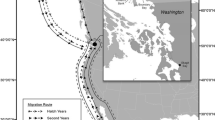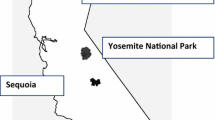Abstract
Vertebrates experience adverse effects from methylmercury, largely obtained through their food. Selenium has the potential to reduce the toxic effects of methylmercury (and vice versa). In this paper, we examine the selenium:mercury molar ratios in tadpoles (Lithobates sphenocephalus, Lithobates catesbeianus (formerly Rana), and a newly documented leopard frog species currently referred to as R. sp. nov.) and fully formed leopard frog metamorphs. There were no significant differences in metal levels between the two leopard frog species, and data were therefore combined. Selenium:mercury molar ratios varied from 19 to 38 for bullfrog tadpoles, from 16 to 330 for leopard frog tadpoles, and from 7 to 17 for leopard frog metamorphs. Leopard frog tadpoles with less than 45 days exposure to field conditions had significantly higher molar ratios than other tadpoles and leopard frog metamorphs. There were significant locational differences for the molar ratios of bullfrogs, and leopard frog tadpoles with more than 45 days of field exposure. At the sites where we were able to sample both leopard frog tadpoles and leopard frog metamorphs, there were significant differences between the two distinct life stages. Most of the variation in the ratio was accounted for by selenium levels, field sites, and exposure period.



Similar content being viewed by others
References
Agency for Toxic Substances and Disease Registry (ATSDR) (2003) Toxicological Profile for Selenium. Centers for Disease Control, Agency for Toxic Substances and Disease Research, Atlanta GA.
Banks MS, Crocker JB, Davis S, Brotherton DK, Cook R, Behler J, Connery B (2006) Population declines of northern dusky salamanders at Acadia National Park, Maine, USA. Biological Conservation 130:230-238.
Banks MS, Crocker J, Connery B, Amirbahman A (2007) Mercury bioaccumulation green frog (Rana clamitans) and gullfrog (Rana catesbeiana) tadpoles from Acadia National Park, Maine, USA. Environmental Toxicology and Chemistry 26: 118-125.
Berry MJ, Ralston NVC (2008) Mercury toxicity and the mitigating role of selenium Ecohealth 5:456-459.
Burger J (2002) Food chain differences affect heavy metals in birds in Barnegat Bay, New Jersey. Environmental Research 90:33-39.
Burger J, Gochfeld M (2001) Effects of Chemicals and Pollution on Seabirds. In: Biology of Marine Birds, Schreiber EA, Burger J (editors), Boca Raton, FL: CRC Press, pp 485-526.
Burger J, Gochfeld M (2012) Selenium and mercury molar ratios in saltwater fish from New Jersey: individual and species variations complicate possible use in human health consumption advisories. Environmental Research 11: 12-23.
Burger J, Snodgrass J (1998) Heavy metals in bullfrog (Rana catesbeiana) tadpoles: effects of depuration before analysis. Environmental Toxicology and Chemistry 17:2203-2209.
Burger J, Snodgrass J (2001) Metal levels in southern leopard frogs from the Savannah River Site: location and body compartment effects. Environmental Research A86:157-166.
Burgess NM, Meyer MW (2008) Methylmercury exposure associated with reduced productivity in common loons. Ecotoxicology 17:83-91.
Cabanero AI, Madrid Y, Camara C (2007) Mercury-selenium species ratio in representative fish samples and their bioaccessibility by an in vitro digestion method. Biology and Trace Elements Research 119:195-211.
Daszak P, Berger L, Cunningham AA, Hyatt HD, Green DE, Speare R (1999) Emerging infectious diseases and amphibian population declines. Emerging Infectious Diseases 5: 735-748.
Eisler R (2000) Selenium: Handbook of chemical risk assessment: health hazards to humans, plants and animals. Boca Raton, FL. Lewis Publishers.
Eisler R (2006) Mercury Hazards to Living Organisms. Taylor and Francis, Boca Raton, FL.
Environmental Protection Agency (EPA) (2001) Water Quality Criterion for the Protection of Human Health: Methylmercury. EPA-823-R-01-001. Office of Water. http://water.epa.gov/scitech/swguidance/standards/criteria/aqlife/pollutants/methylmercury/upload/2009_01_15_criteria_methylmercury_mercury-criterion.pdf. Accessed 28 July 2011
Evers DC, Jackson AK, Tear TH, Osborne CE (2012) Hidden Risk: Mercury in Terrestrial Ecosystems of the Northeast. BRI Report 2012-07-33. Gorham, ME: Biodiversity Research Institute
Fitzgerald WF, Lamborg CH, Hammerschmidt CR (2007) Marine biogeochemical cycling of mercury. Chemical Reviews 107: 641-662.
Frederick P, Jayasena N (2010) Altered pairing behaviour and reproductive success in white ibises exposed to environmentally relevant concentrations of methylmercury. Proceedings of the Royal Society. doi:10.1098/rspb.2010.2189.
Frederick PC, Hylton B, Heath JA, Spalding MG (2004) A historical record of mercury contamination in southern Florida (USA) as inferred from avian feather tissue. Environmental Toxicology and Chemistry 23:1474-1478.
Gossner KL (1960) A simplified table for staging anuran embryos and larvae with identification. Herpetological 16:183-190.
Institute of Medicine (IOM) (2006) Seafood choices: balancing benefits and risks. National Academy Press, Washington, DC.
Jackson AK, Evers DC, Etterson MA, Condon Folsom SB, Detweiler J, Schmerfeld J, et al. (2011) Mercury exposure affects the reproductive success of a free-living terrestrial songbird, the Carolina Wren (Thryothorus ludovicianus). Auk 128:759-769.
Lannoo, M. (Ed.) (2005). Amphibian Declines: The Conservation Status of United States Species. University of California Press, USA.
National Research Council (NRC) (2000) Toxicological effects of methylmercury. National Academy Press, Washington DC.
Newman CE, Feinberg JA, Rissler LJ, Burger J, Shaffer HB (2012). A new species of leopard frog (Anura:Ranidae) from the urban northeastern U.S. Molecular Phylogenetic and Evolution 63: 445-455.
Ohlendorf H, Hothem RL Walsh D (1989) Nest success, cause-specific nest failures and hatchability of aquatic birds at selenium contaminated Kesterson Reservoir and a reference site. Condor 91:787-796.
Ohlendorf H, Hothem RL, Bunck CM, Marois KC (1990) Bioaccumulation of selenium in birds at Kesterson Reservoic, California. Archives of Environmental Contamination and Toxicology 19:495-507.
Peterson SA, Ralston NVC, Peck DV, Van Sickle J, Robertson JD, Spate VL, Morris JS (2009) How might selenium moderate the toxic effects of mercury in stream fish in western US? Environmental Science and Technology 43:3919–3925.
Pinheiro MCN, de Nascimento JLM, Silveira LCL, daRocha JBT, Aschner M (2009) Mercury and selenium – a review on aspects related to the health of human populations in the Amazon. Environmental Bioindicators 4:222-245.
Ralston NVC (2008) Selenium health benefit values as seafood safety criteria. EcoHealth 5:442-455.
Ralston NVC (2009) Introduction to 2nd issue on special topic: selenium and mercury as interactive environmental indicators. Environmental Bioindicators 4:286-290.
Ralston NVC, Raymond LJ (2010) Dietary selenium’s protective effects against methylmercury toxicity. Toxicology 278:112-123.
Ralston NVC, Ralston CR, Blackwell III JL, Raymond LJ (2008) Dietary and tissue selenium in relation to methylmercury toxicity. Neurotoxicology 29:802-811.
Rattner B (2000) Environmental Contaminants and Colonial Waterbirds. Laurel, MD: USGS Patuxent Wildlife Research Center. http://waterbirdsconservation.org/plan/rpt-contaminants.pdf. Accessed 14 Jan 2012
Raymond LJ, Ralston NVC (2009) Selenium’s importance in regulatory issues regarding mercury. Fuel Processing Technology 90:1333-1338.
Relyea RA (2004) Synergistic impacts of malathion and predatory stress on six species of North American tadpoles. Environmental Toxicology and Chemistry 23:1080-1084.
Semlitsch RD, Wake DB (2003) Amphibian conservation. Smithsonian Books, Washington, DC.
SAS (Statistical Analysis Systems) (2005) Statistical Analysis. SAS, Cary, SC.
Stuart, S.C., Chanson, J.S., Cox, N.A., Young, B.E., Rodrigues, A.S.L., Fishman, D.L. and Waller, R.W. (2004). Status and trends of amphibian declines and extinctions. Science 306: 1783.
Todd BD, Bergeron CM, Hepner, MJ, Hopkins WA (2011) Aquatic and terrestrial stressors in amphibians: a test of the double jeopardy hypothesis based on maternally and trophically derived contaminants. Environmental Toxicology and Chemistry 30: 2277-2284.
Unrine JM, Jagoe CH, Hopkins WA, Brant HA (2004) Adverse effects of ecologically relevant dietary mercury exposure in southern leopard frog (Rana sphenocephala) larvae. Environmental Toxicology and Chemistry 23: 2964-2970.
Acknowledgments
We thank the many people who have discussed mercury, selenium, and molar ratios with us, including Melanie Lémire, Kate Mahaffey, Donna Mergler, Nick Ralston, Rita Schoeny, Alan Stern, Helmut Zarbl, and Tim Green, as well as two anonymous reviewers. The views and conclusions expressed in this paper are solely those of the authors, and do not reflect the funding agencies. This research was partly supported by the Brookhaven National Laboratory, Foundation for Ecological Research in the Northeast, New York State Biodiversity Research Institute, Long Island Community Foundation, the Rutgers University Graduate School of New Brunswick and Graduate Program in Ecology and Evolution, NIEHS Center Grant (P30ES005022), the Consortium for Risk Evaluation with Stakeholder Participation (Department of Energy, DE-FC01-06EW07053), and EOHSI. This research was conducted under a Rutgers University Protocol, and samples were collected under appropriate state permits.
Author information
Authors and Affiliations
Corresponding author
Rights and permissions
About this article
Cite this article
Burger, J., Feinberg, J., Jeitner, C. et al. Selenium:Mercury Molar Ratios in Bullfrog and Leopard Frog Tadpoles from the Northeastern United States. EcoHealth 11, 154–163 (2014). https://doi.org/10.1007/s10393-014-0913-3
Received:
Revised:
Accepted:
Published:
Issue Date:
DOI: https://doi.org/10.1007/s10393-014-0913-3




